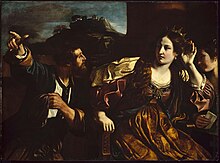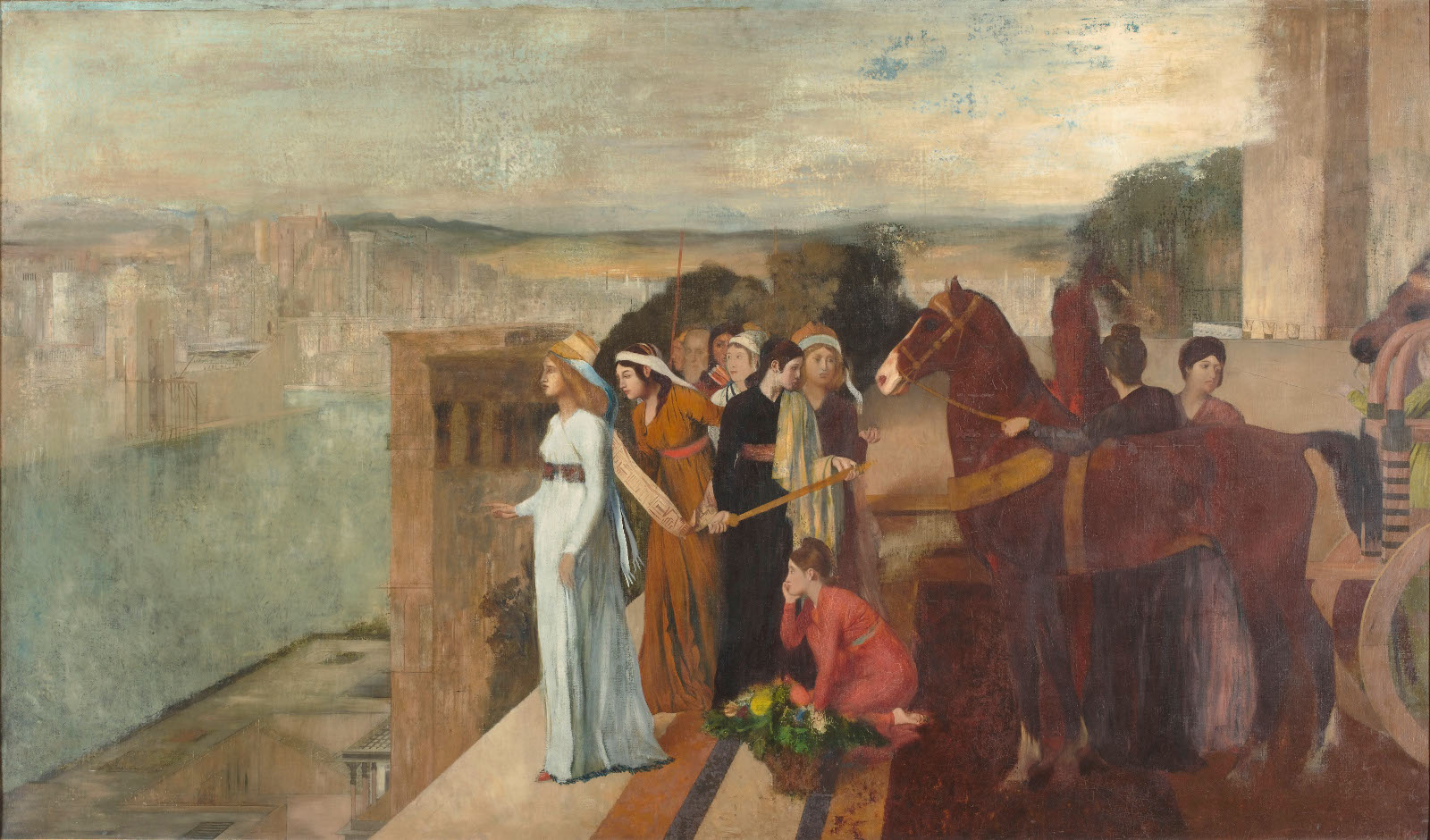Ancient Assyria was brutal. Warmongering and conquest was an enormous part of the culture, and women had no place in war or political leadership¹. Queen Sammuramat, however, had a place in both.
Unfortunately, there's not a lot of definitive, reliable information about Sammuramat. She lived before 1000 BCE, and it's difficult to retrieve written, official records from that era. However, it's a pretty good bet that Sammuramat was something special, because she's the basis for the legendary Semiramis, and legends don't usually spring out of nowhere.
But first the facts. We know that Sammuramat was the wife of king Shamshi-Adad V, and that after he died in battle she took the throne as regent for her son, Adad-Nirari III. She was involved in invasions of Armenia² and India, and she was a great builder. We also know that she held her throne for between 30-40 years--pretty impressive for a ruler of that time period.
And that would be about the end of the stone cold fact for Sammuramat, the rest is guesswork based off the myths of Queen Semiramis. There are enough similarities between Semiramis and Sammuramat to presume that Semiramis is based off of Sammuramat, Hellenization of her name aside.
According to the myths, Semiramis was the the daughter of Derceto, a Syrian fish goddess, and a handsome youth who served Derceto. Ashamed at having done the deed with a mortal, Derceto killed the youth, and abandoned Semiramis on the banks of a river to die. Luckily for Semiramis, the local avian community decided to keep her alive. Doves brought her food and milk, and covered her for warm. They nourished her until the keeper of the king's herds--Semmis-- found her and adopted her. All of this demi-goddess and dove nonsense later led to Semiramis being associated with Ishtar/Inanna/Astarte after her death.
Semiramis possessed, or course, an unearthly beauty, and so when Onnes, the governor of Syria, saw her, he immediately asked for her hand in marriage. Semmis agreed, and the pair married. According to legend, they were quite in love, and had two sons together. Legend also claims that not only was Semiramis really attractive, she was also really smart. Smart enough that Onnes consulted her before doing pretty much anything. So when the king asked Onnes to go to war, it wasn't long before Onnes asked Semiramis to join him.
The Assyrian army had been unsuccessfully attacking the city of Bactra in modern day Afghanistan when Semiramis turned up. She had been wearing long robes that covered her skin and made it impossible to tell if she was male or female³. When she arrived on the battlefield, she saw Assyrian soldiers besieging the city from every angle except at the raised acropolis, which was undefended. Choosing a group of soldiers skilled at climbing, Semiramis led the men, and captured the acropolis, bringing down the city.
Shamshi-Adad was, understandably, intrigued to see who had captured the city he'd been going after for forever. When Onnes introduced him to his lovely wife, Shamshi-Adad fell instantly in love. He ordered Onnes to let him have Semiramis. Though the king said that Onnes could marry his daughter as recompense, Onnes wasn't too keen on that, and he went and hanged himself. Semiramis' feelings are unknown.
Sources disagree upon how exactly Semiramis came to the throne, but the most common story is that she convinced Shamshi-Adad to let her have power for five days. He agreed to do so, and in the biggest power move of the BCEs, Semiramis had him executed, and declared herself regent.
Next Semiramis started engaging in the traditional hobbies of kings--conquest, building, and sex. According to the legends, she was a master of all three. She lead a successful invasion of Armenia, kept stability in the restless Assyrian empire, and led an invasion of India that may or may not have gone well depending on who you ask. Semiramis for sure built the embankments at Babylon, but she's also credited with building the city of Babylon and the famous hanging gardens. (Spoiler alert, she didn't do either of those things) According to Armenian legends, she carved wisdom on the unbreakable stones near modern day Van.
And, of course, the most lurid myths about Semiramis are the myths about her insatiable sexual appetites. Wherever famous and powerful women go, myths about their voracious lust follow them. In Semiramis' case, the myths are that she never remarried in order to preserve her power, but instead took lovers from an elite regiment of guards in her army. After one night of passion, she had her lover executed to prevent endangering the political stability she worked so hard for.
Sammuramat, while definitely a colorful character, could not possibly have done all the things that the mythical Semiramis did. Historical dating of the ruins of Babylon prove that it existed long before she did, and the writing in the caves above Van, while written in Cuneiform, is not written in the Assyrian language. What is true, however, is that myths and legends grow up around powerful and exceptional people. A woman holding power, and for that long, in ancient Assyria was completely unprecedented, it only follows that myths would spring up around her, if not only to justify the status quo. By making Sammuramat a demigoddess with superhuman skills the Assyrians guaranteed that she would be the exception, not the rule. By making Sammuramat the exception, it was ensured that it would be incredibly difficult for another woman to hold the throne.
¹Enheduanna, remember, was Sumerian. The Sumerians and Assyrians, though they share a homeland and are often lumped together under the term 'Mesopotamian', are different civilizations.
²The Armenians aren't too fond of her
³Some myths attribute Semiramis with the invention of the chador.
Sources
Semiramis
Sammu-ramat
Sammu-Ramat and Semiramis: The Inspiration and the Myth
The True Story of Semiramis, Legendary Queen of Babylon
Sammuramat
 |
| Semiramis Hears of the Insurrection of Babylon by Giovanni Francesco Barbieri |
But first the facts. We know that Sammuramat was the wife of king Shamshi-Adad V, and that after he died in battle she took the throne as regent for her son, Adad-Nirari III. She was involved in invasions of Armenia² and India, and she was a great builder. We also know that she held her throne for between 30-40 years--pretty impressive for a ruler of that time period.
And that would be about the end of the stone cold fact for Sammuramat, the rest is guesswork based off the myths of Queen Semiramis. There are enough similarities between Semiramis and Sammuramat to presume that Semiramis is based off of Sammuramat, Hellenization of her name aside.
According to the myths, Semiramis was the the daughter of Derceto, a Syrian fish goddess, and a handsome youth who served Derceto. Ashamed at having done the deed with a mortal, Derceto killed the youth, and abandoned Semiramis on the banks of a river to die. Luckily for Semiramis, the local avian community decided to keep her alive. Doves brought her food and milk, and covered her for warm. They nourished her until the keeper of the king's herds--Semmis-- found her and adopted her. All of this demi-goddess and dove nonsense later led to Semiramis being associated with Ishtar/Inanna/Astarte after her death.
 |
| Map of the Assyrian Empire |
The Assyrian army had been unsuccessfully attacking the city of Bactra in modern day Afghanistan when Semiramis turned up. She had been wearing long robes that covered her skin and made it impossible to tell if she was male or female³. When she arrived on the battlefield, she saw Assyrian soldiers besieging the city from every angle except at the raised acropolis, which was undefended. Choosing a group of soldiers skilled at climbing, Semiramis led the men, and captured the acropolis, bringing down the city.
Shamshi-Adad was, understandably, intrigued to see who had captured the city he'd been going after for forever. When Onnes introduced him to his lovely wife, Shamshi-Adad fell instantly in love. He ordered Onnes to let him have Semiramis. Though the king said that Onnes could marry his daughter as recompense, Onnes wasn't too keen on that, and he went and hanged himself. Semiramis' feelings are unknown.
 |
| Cuneiform on a rock near Van, Armenia. This writing is sometimes attributed to Semiramis in myths |
Next Semiramis started engaging in the traditional hobbies of kings--conquest, building, and sex. According to the legends, she was a master of all three. She lead a successful invasion of Armenia, kept stability in the restless Assyrian empire, and led an invasion of India that may or may not have gone well depending on who you ask. Semiramis for sure built the embankments at Babylon, but she's also credited with building the city of Babylon and the famous hanging gardens. (Spoiler alert, she didn't do either of those things) According to Armenian legends, she carved wisdom on the unbreakable stones near modern day Van.
And, of course, the most lurid myths about Semiramis are the myths about her insatiable sexual appetites. Wherever famous and powerful women go, myths about their voracious lust follow them. In Semiramis' case, the myths are that she never remarried in order to preserve her power, but instead took lovers from an elite regiment of guards in her army. After one night of passion, she had her lover executed to prevent endangering the political stability she worked so hard for.
 |
| Semiramis Inspecting the City of Babylon by Degas |
¹Enheduanna, remember, was Sumerian. The Sumerians and Assyrians, though they share a homeland and are often lumped together under the term 'Mesopotamian', are different civilizations.
²The Armenians aren't too fond of her
³Some myths attribute Semiramis with the invention of the chador.
Semiramis
Sammu-ramat
Sammu-Ramat and Semiramis: The Inspiration and the Myth
The True Story of Semiramis, Legendary Queen of Babylon
Sammuramat

No comments:
Post a Comment
Thank you so much for commenting! We have turned on comment moderation in order to cut down on the amount of spam and promotional material being sent to us. Provided your comment is not attempting to sell something, your comment will be published within the next 48 hours.